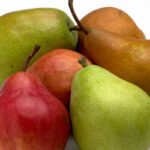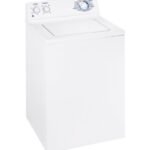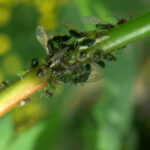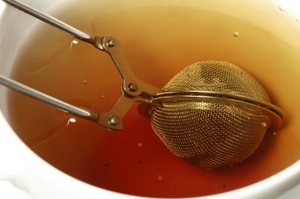If the leaves of your red currants are looking discolored, blistered or puckered, they may have an aphid problem that needs to be addressed. Aphids are very small, barely visible to the naked eye. They have soft, fat, pear-shaped bodies and range in a variety of different colors from red, green, black, yellow and brown. When looking for aphids, examine the undersides of the red currant’s leaves. If you don’t take care of the aphids, they will multiply rapidly. One aphid can produce 80 offspring in a week and can breed several times during its life cycle. That can result in your plants having a lot of aphids.
Spray Aphids Away
The best way to eradicate aphids or any bugs for that matter is organically. This way, the fruit won’t be harmed, only the aphids. Hook up the water hose and attach a sprayer nozzle to the end. Turn the water pressure to full flow and spray the red currant bush with water. The blast should dislodge the aphids, leaving them unable to return to the red currants.
If a strong current of water seems too harsh, fill a small sprayer bottle with warm water and add 2 teaspoons of liquid dish soap. Spray the undersides of the red currants’ leaves. This mixture removes the protective waxy coating that covers the aphids and will kill the aphids, which will dehydrate. Repeat the application once a week or until the aphids are gone.
Spray the red currant plants with a mixture of 3 parts warm water, 1 part vegetable oil and 1/4 teaspoon of dish soap. Shake to mix the ingredients and use this to spray the mixture on the undersides of red currants’ leaves. The oil clogs the aphid’s respiratory spiracles. Wash the fruit before eating to remove the oil spray. Repeat weekly until the aphids are gone. Do not use this spray of a hot day because the oil can intensify the sun’s heat and damage the leaves.
Cut off Aphid Colonies
Examine the underside of the red currant bush for aphid colonies. If you find a section full of aphids, cut off the branch and throw it away. Do not throw the infected branch into a compost pile, because the aphids won’t die. You will be locating them to another part of your garden when you use the compost. Seal the branch in a black plastic bag and place it in the sun. The heat of the sun will cook the aphids and kill them. Toss the bag out for the garbage truck to take away.
Hang a Tag Board
Hang up a yellow tag board, which will attract aphids. This board has a sticky substance over both sides similar to double-sided tape. When the aphids step on it, they remain stuck to the board and die. Check the tape several times a week and when the tag board becomes full of aphids, throw it away and hang up a new one.
Predatory Insects
Add predatory insects to the red currant shrubs. These bugs include lady bugs in the adult and larvae form, and lacewing larvae. Try to lure wrens into the red currant area by hanging wren houses in the trees. Do not use yellow tag boards if you are releasing predatory insects, because they will become stuck in the glue-like substance. Spray the red currant trees with insecticidal oil, which is a natural chemical made from seeds and fruits. The oil will kill the aphids but not the other beneficial insects. Read and follow label directions when using insecticidal oil .
Sources:
Colorado State University Extension; Aphids on Shade Trees and Ornamentals
Giant Book of Garden Solutions”; Jerry Baker; 2003
“Old-Time Gardening Wisdom”; Jerry Baker; 1999






